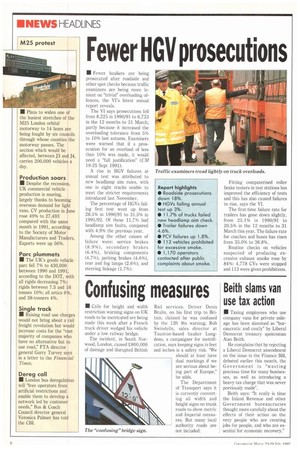Fewer HGV prosecutions
Page 8

If you've noticed an error in this article please click here to report it so we can fix it.
• Fewer hauliers are being prosecuted after roadside and other spot checks because traffic examiners are being more lenient on "trivial" overloading offences, the VI's latest annual report reveals.
The VI says prosecutions fell from 8,225 in 1990/91 to 6,733 in the 12 months to 31 March, partly because it increased the overloading tolerance from 5% to 10% last autumn. Examiners were warned that if a prosecution for an overload of less than 10% was made, it would need a "full justification" (CM 19-25 Sept 1991).
A rise in HGV failures at annual test was attributed to new headlamp aim rules, with one in eight trucks unable to meet the stricter requirements introduced last November.
The percentage of HGVs failing first test went up from 28.5% in 1990/91 to 31.5% in 1991/92. Of these 11.7% had headlamp aim faults, compared with 4.9% the previous year.
Among the other causes of failure were: service brakes (8.9%), secondary brakes (6.4%), braking components (4.7%), parking brakes (4.6%), rear and fog lamps (2.6%), and steering linkage (1.7%). Fitting computerised roller brake testers in test stations has improved the efficiency of tests and this has also caused failures to rise, says the VI.
The first-time failure rate for trailers has gone down slightly, from 25.1% in 1990/91 to 20.5% in the 12 months to 31 March this year. The failure rate for coaches and buses has risen from 35.0% to 36.8%.
Routine checks on vehicles suspected of producing excessive exhaust smoke rose by 84%: 4,778 CVs were stopped and 113 were given prohibitions.
















































































